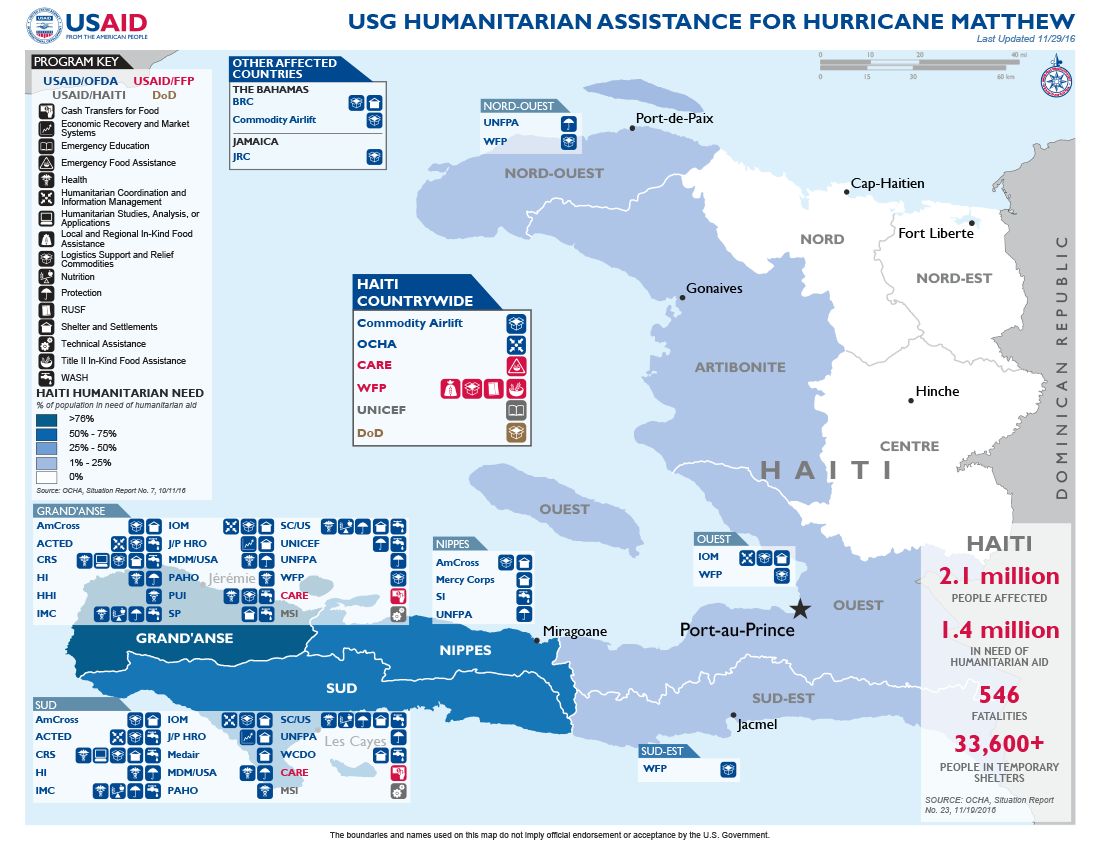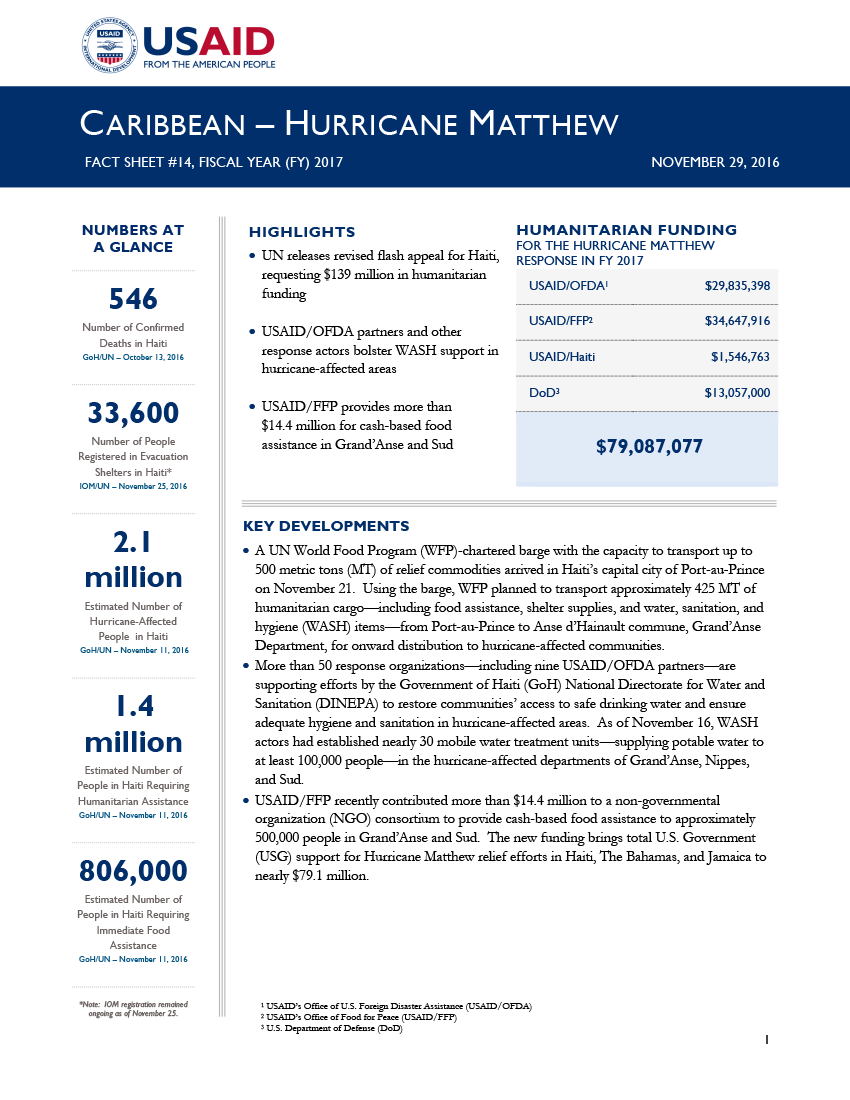November 29, 2016
Highlights
UN releases revised flash appeal for Haiti, requesting $139 million in humanitarian funding.
USAID/OFDA partners and other response actors bolster WASH support in hurricane-affected areas.
USAID/FFP provides more than $14.4 million for cash-based food assistance in Grand’Anse and Sud.
Key Developments
Numbers At A Glance
546
33,600
2.1 million
1.4 million
806,000
Humanitarian Funding
For the Hurricane Matthew Response
in FY 2017
| USAID/OFDA | $29,835,398 |
| USAID/FFP | $34,647,916 |
| USAID/Haiti | $1,546,763 |
| DoD | $13,057,000 |
| TOTAL | $79,087,077 |
A UN World Food Program (WFP)-chartered barge with the capacity to transport up to 500 metric tons (MT) of relief commodities arrived in Haiti’s capital city of Port-au-Prince on November 21. Using the barge, WFP planned to transport approximately 425 MT of humanitarian cargo—including food assistance, shelter supplies, and water, sanitation, and hygiene (WASH) items—from Port-au-Prince to Anse d’Hainault commune, Grand’Anse Department, for onward distribution to hurricane-affected communities.
More than 50 response organizations—including nine USAID/OFDA partners—are supporting efforts by the Government of Haiti (GoH) National Directorate for Water and Sanitation (DINEPA) to restore communities’ access to safe drinking water and ensure adequate hygiene and sanitation in hurricane-affected areas. As of November 16, WASH actors had established nearly 30 mobile water treatment units—supplying potable water to at least 100,000 people—in the hurricane-affected departments of Grand’Anse, Nippes, and Sud.
USAID/FFP recently contributed more than $14.4 million to a non-governmental organization (NGO) consortium to provide cash-based food assistance to approximately 500,000 people in Grand’Anse and Sud. The new funding brings total U.S. Government (USG) support for Hurricane Matthew relief efforts in Haiti, The Bahamas, and Jamaica to nearly $79.1 million.
HUMANITARIAN ACCESS AND LOGISTICS SUPPORT
While the Haitian National Police and the UN Stabilization Mission in Haiti (MINUSTAH) remain responsible for providing escorts for large-scale humanitarian distributions, response organizations are bolstering community engagement efforts to reduce reliance on armed escorts, per a mid-November directive from UN Deputy Humanitarian Coordinator Sebastian Rhodes Stampa. On November 28, the Sud departmental emergency operations center (COUD) hosted a working group session on community engagement for reponse actors to share best practices in order to minimize the risk of looting and other security incidents.
Access to mountainous communities in hurricane-affected areas remains challenging, the UN reports. During the week of November 22, heavy rains and landslides in Grand’Anse’s Jeremie commune and nearby locations limited food distributions in hard-to-reach sites and temporarily prevented mobile health clinics from accessing Anse d’Hainault, Dame Marie, and Les Irois communes, according to the UN. The WFP-led Logistics Working Group—the coordinating body for humanitarian logistics activities, comprising UN agencies, NGOs, and other stakeholders—is monitoring the conditions of secondary roads to identify access constraints and improve related coordination and planning efforts.
On November 21, a WFP-chartered barge with transport capacity of approximately 500 MT arrived in Port-au-Prince. The barge, intended to augment humanitarian actors’ capacity to supply relief commodities to hard-to-reach coastal areas, brings WFP’s cumulative sea transport capacity to 610 MT. Using the barge, WFP planned to transport approximately 425 MT of humanitarian cargo—including food assistance, shelter supplies, and WASH items—from Port-au-Prince to Anse d’Hainault for onward distribution by USAID partners the Agency for Technical Cooperation and Development (ACTED) and WFP.
EMERGENCY FOOD ASSISTANCE
Preliminary results from a recent USAID-funded Famine Early Warning Systems Network (FEWS NET) assessment indicate that some households in southwestern Haiti are experiencing Crisis—IPC 3—or worse levels of food insecurity, representing a deterioration from the Minimal—IPC 1—levels experienced prior to the hurricane. Ongoing humanitarian food assistance to affected areas may be preventing higher levels of food insecurity, FEWS NET reports.
With support from USAID/FFP, WFP continues to address the urgent food needs of hurricane-affected communities. As of November 25, WFP and implementing partners had distributed approximately 6,600 MT of emergency food assistance to an estimated 630,000 people—nearly 79 percent of the 800,000 people targeted—in Grand’Anse, Nippes, and Sud. WFP also provided blanket supplementary food products to prevent and treat acute malnutrition to approximately 3,130 children younger than five years of age. From November 25–27, WFP and implementing partners reached an additional 6,800 households in Grand’Anse and Sud with food assistance, according to USAID/FFP staff in Haiti. WFP plans to conclude all remaining first phase food distributions during the week of November 28.
In the coming months, WFP and other food security actors plan to transition from in-kind food distributions to cash-based food assistance, as market recovery allows, to promote and restore local economic activity. Food security stakeholders anticipate that unconditional cash assistance will transition to cash-for-work programs beginning in January 2017. In-kind food assistance will continue throughout this period in areas where local markets are unable to meet household food needs, response actors report.
USAID/FFP recently provided more than $14.4 million to an NGO consortium—led by CARE and including ACTED, Catholic Relief Services (CRS), Food for the Hungry, and Mercy Corps—to provide cash-based food assistance to hurricane-affected families. The consortium plans to provide unconditional cash transfers—meeting approximately 80 percent of beneficiaries’ monthly food needs—to more than 500,000 individuals in Grand’Anse and Sud. After an initial distribution of unconditional cash assistance, CARE and partners intend to transition to cash-forwork activities that will assist approximately 98,000 beneficiaries, thereby increasing vulnerable households’ access to food, while restoring community assets damaged by the hurricane.
HEALTH AND WASH
Response actors continue to support cholera prevention and treatment efforts in the aftermath of Hurricane Matthew. The GoH Ministry of Public Health and Population (MSPP) reported nearly 470 new suspected cholera cases in Grand’Anse and Sud between November 6 and 12—consistent with the number of cases reported the previous week. Health actors had treated approximately 1,800 suspected cholera cases in hurricane-affected areas as of early November, according to the UN.
MSPP is finalizing data from the oral cholera vaccination campaign conducted in Grand’Anse and Sud between November 8 and 18. As of November 25, preliminary results indicated that the campaign reached more than 729,200 people, including an estimated 364,600 people in Sud and 364,530 people in Grand’Anse—approximately 90 percent of the 820,000 people targeted for vaccination.
U.S. Centers for Disease Control and Prevention (CDC) staff continue to support MSPP to perform cholera-related epidemiology and surveillance efforts, including through case investigation, specimen collection and testing, and training for laboratory technicians.
WASH actors—including USAID/OFDA partners CRS and Samaritan’s Purse (SP)—are working to promote strong hygiene practices and effective sanitation in hurricane-affected areas of Grand’Anse and Sud. With USAID/OFDA support, CRS is conducting hygiene promotion activities in Grand’Anse’s Caricolie community and Marcfranc commune, while SP is training more than 40 community-based agents to promote safe hygiene practices in Grand’Anse’s Abricots and Bonbon communes. As of November 16, humanitarian organizations had reached at least 130,000 people in 10 communes with hygiene promotion activities in Grand’Anse and Sud.
More than 50 response organizations are supporting DINEPA’s efforts to restore communities’ access to safe drinking water and ensure adequate hygiene and sanitation in hurricane-affected areas, according to the WASH Working Group. As of November 16, WASH actors had established nearly 30 mobile water treatment units—supplying potable water to at least 100,000 people—in Grand’Anse, Nippes, and Sud. Response actors had also distributed approximately 3.5 million Aquatabs and bottled water to an estimated 73,000 people across the three departments. Additionally, with support from the World Bank, DINEPA plans to rehabilitate more than 70 water supply networks in hurricane-affected areas.
Through USAID/OFDA assistance, SP is restoring rural communities’ access to safe drinking water through the rehabilitation of 11 piped water networks and the protection of five fresh water springs in Abricots and Bonbon. Additionally, USAID/OFDA partners CRS and the UN Children’s Fund (UNICEF) are coordinating with sub-grantee Water Mission to restore access to clean drinking water in Grand’Anse, including through the establishment of a water treatment plant—capable of producing up to 160,000 liters of water per day—in Grand’Anse’s Jeremie city. The facility supplies approximately 10 liters of safe drinking water to an estimated 10,000 people daily, reaching approximately 20 percent of the city’s inhabitants. Water Mission is also operating six water treatment units—providing sufficient water for approximately 18,000 people—in Grand’Anse’s Anse d’Hainault, Dame-Marie, and Jeremie communes.
SHELTER AND SETTLEMENTS
Response actors continue to report forced evacuations of displaced people temporarily sheltering in schools in Grand’Anse and Sud, according to the UN. The USAID Disaster Assistance Response Team (DART) is collaborating with partners and local authorities to develop a coordinated strategy for addressing the needs of residual shelter populations, particularly amid the ongoing risk of forced evictions from temporary shelters. USAID/OFDA partners plan to utilize data from the International Organization for Migration (IOM) Displacement Tracking Matrix to identify displaced households’ areas of origin and conduct multi-sector needs assessments.
As part of its emergency returns response, USAID/OFDA partner Save the Children/U.S. (SC/US) had distributed plastic sheeting and rope to approximately 2,560 households in Sud’s Beaumont, Camp-Perrin, and Torbeck communes as of November 28. As of November 14, relief actors in Haiti had distributed plastic sheeting to nearly 403,000 people in the three departments, according to the Shelter/Non-Food Item Working Group. USAID/OFDA partners and locally-based USAID/OFDA consultants are providing technical guidance to recipients on the proper utilization of shelter kits and to ensure the appropriate construction of temporary shelters.
HUMANITARIAN COORDINATION AND INFORMATION MANAGEMENT
USAID/Haiti is supporting Management Systems International (MSI) to provide five short-term technical advisors— including communications, geographic information systems, logistics, and social protection specialists—to support DPC coordination activities in Grand’Anse and Sud. Additionally, with $250,000 in assistance from USAID/OFDA, the UN Office for the Coordination of Humanitarian Affairs (OCHA) is strengthening humanitarian coordination among the GoH, UN officials, relief organizations, and other stakeholders to ensure a more effective and coherent response.
OTHER HUMANITARIAN ASSISTANCE
In late November, OCHA released a revised flash appeal to reflect both delivered humanitarian assistance and the outstanding critical needs of hurricane-affected people in Haiti. The revised appeal requests a total of $139 million—an increase of approximately $19 million—and seeks to provide emergency food assistance to 806,000 people; emergency relief commodities to 805,000 people; and health and WASH assistance to 750,000 people, among other interventions. As of November 29, international donors had contributed $64.3 million—approximately 46 percent of the requested total—toward the revised flash appeal, according to the OCHA Financial Tracking Service.
CONTEXT
Hurricane Matthew made initial landfall near Haiti’s Les Anglais commune, Sud, and secondary landfall over eastern Cuba on October 4 before continuing to traverse The Bahamas from October 5–7. The hurricane brought destructive winds, heavy rainfall, and dangerous storm surge, resulting in extensive damage to crops, houses, and infrastructure, as well as widespread flooding in some areas.
On October 2, U.S. Ambassador to Haiti Peter F. Mulrean and U.S. Chargé d’Affaires, a.i., for Jamaica Eric Khant issued disaster declarations in response to the anticipated effects of Hurricane Matthew. U.S. Chargé d’Affaires, a.i., Lisa A. Johnson issued a disaster declaration in response to the anticipated effects of Hurricane Matthew in The Bahamas on October 4.
USAID activated a regional DART on October 3 with staff in The Bahamas, Haiti, and Jamaica. USAID also stood up a Washington, D.C.-based Response Management Team to coordinate the regional humanitarian response.
Based on assessment findings and in consultation with government representatives in the two countries, USAID discontinued DART operations in Jamaica and The Bahamas on October 5 and 13, respectively. USAID/OFDA regional staff will continue to monitor USAID/OFDA assistance provided to the Bahamas Red Cross (BRC) and the Jamaica Red Cross (JRC) to address the immediate needs of populations affected by Hurricane Matthew.









Comment
Make a general inquiry or suggest an improvement.